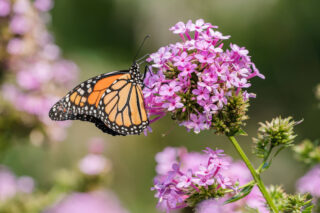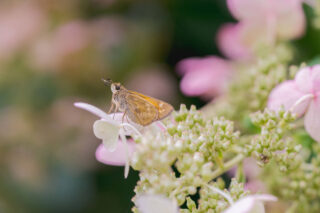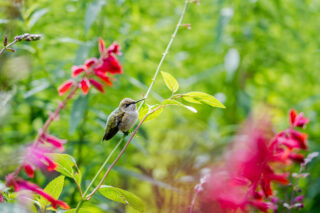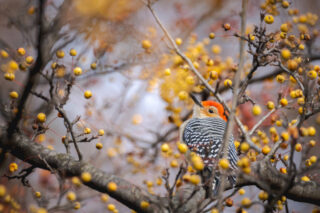Build It and They Will Come: How to Grow a Pollinator Garden
This Earth Month, we’re bringing you a few ways that you can add eco-friendly habits into your lifestyle.
A sustainable switch that’s both beneficial and beautiful is a pollinator garden. Planting flowers in your landscape that are nectar-producing—and even better, native—will attract pollinators like butterflies, birds, moths, and more, and encourage them to spread these plants, which are crucial for the entire ecosystem to survive.
Have any questions as you get started on your gardening journey? Ask our experts in the Mertz Library, the Plant Doctors, by filling out this form.
Butterfly Garden

There are around 17,500 recorded species of butterflies in the world, and around 750 species in the U.S., according to the Smithsonian. For their size, the migration of butterflies is almost unfathomable. One of the most widely known voyages is that of the monarch butterfly, which migrates in the fall from breeding grounds in the Northern U.S. to overwintering sites in southern California and Mexico (Smithsonian). Each year, thousands of Eastern monarch butterflies traverse up to 3,000 miles for each leg of the journey, traveling up to 50 miles a day, and flying up to a mile high in the sky. Because each butterfly has such a short life cycle (about 4 weeks), this means that it takes roughly 4 generations to reach their northern destination (U.S. Fish & Wildlife), while one “super generation” completes the entire journey south. This generation spends the winter in Mexico or southern California until their internal clock tells them to start migrating north. Once this happens, the female monarchs lay eggs and die, letting the new generation hatch to carry on northward.
Pollinator habitats are therefore imperative to make their journey easier—and even more so, to ensure they get the rest and food they need to survive. About 19% of butterflies in the U.S. are at risk of extinction (Xerces Society). As of 2022, the monarch butterfly became classified as an endangered species, the native U.S. population having shrunk between 22% and 72% over the last decade; with the eastern population having shrunk by 84% over the last two decades; and the western population having declined by an estimated 99.9% between the 1980s and 2021 (IUCN).

Though the range of migration distance for various butterfly species varies, the monarch’s path and complicated lifecycle only adds to its vulnerability, especially when flying across human-altered landscapes. It’s clear how much of an impact we can make by including plants like native milkweed in our green spaces, terraces, gardens, and even the grassy patches between sidewalks and roads!
To attract butterflies, use these tips from our Plant Docs in the Mertz Library:
- Provide stands of fragrant, flowering plants rather than single plants.
- Grow flowers in full sun, with shelter from the wind, throughout the growing season.
- Yellow and purple flowers are especially appealing.
- Plants of differing heights and flower sizes will attract the greatest variety of species.
- Provide nectar sources for adult butterflies.
- Provide a water feature such as a fountain, birdbath, or mud puddle. Place a few flat stones around and give them a place to bask in the sun!
A butterfly’s life cycle includes four distinct stages: egg, caterpillar (larva), chrysalis (pupa), and adult. Your garden will mostly impact the caterpillar (larval stage) and the butterfly (adult stage). In order to attract butterflies, you may have to share your garden with some hungry caterpillars—but don’t worry, most butterfly larvae will not feed on more valuable ornamental plants!
There must be enough food plants for caterpillars to foster an adequate population of butterflies—therefore, growing a diversity of plants, especially crops in the parsley and broccoli families, is important. Make sure you also provide nectar sources for adult butterflies. Milkweeds are amazing sources of nectar and are also critical in the life cycle of monarchs—their caterpillars exclusively feed on milkweeds.
The Plant Doctors have also provided a list of butterfly-friendly flowers and plants—as well as the species they attract. Here are just a few:
- Azalea
- Clover
- Bee balm
- Honeysuckle
- Milkweed
- Lilacs
- Goldenrod
- Mustard
- Nasturtium
Bird Garden

Like butterflies, birds bring a serene beauty to any garden—plus, the delight of birdsong—and are key to the ecological balance of the landscape through keeping insect populations in check and distributing seed. Similar to their fellow winged pollinators in the insect world, birds are also incredibly vulnerable, especially the migratory species. BirdLife International points out that one in eight species is now threatened with extinction, and since 1970, nearly three million birds are estimated to have been lost in North America. According to the American Bird Conservancy, habitat loss is considered the principal threat for 189 native bird species. Just by providing shelter and food for birds in your backyard, you can help!

As with any living thing, birds need these bare necessities. When creating a bird garden, here are some design elements and other tips to keep in mind:
- Birds need shelter from the elements and from other predators.
- You can design your garden with varying layers—tall trees, medium-sized shrubs, ornamental grasses, and more to accommodate many different types of birds.
- Birds need food such as seeds, fruits, and insects.
- Pick a variety of plants that provide food at different times of the season and attract a range of bird species. Plant shrubs with food like berries in groups of threes, fives, or sevens to give a buffer so that there is enough food at one time.
- You can also attract insects by leaving leaf litter in your perennial beds or under your shrubs. The leaves compost, not only providing important nutrients to the soil, but also creating a haven for the insects many birds love to eat.
- Make a homemade bird feeder! Follow instructions at the bottom of this page.
- Water is necessary for hydration and bathing.
- You can put a bird bath or large, shallow dish of water in your garden, which is both decorative and functional. Smaller birds tend to bathe in a half-inch of water, while larger birds prefer a depth of two inches. You can also put a couple bigger rocks in the bird bath so that birds can perch and drink.
- Dust baths are welcome as well—create one in a sunny spot near the area where your birds feed!
- Though specific to every bird, nesting sites are incredibly crucial.
- Some birds like to build their nests in evergreens, some in deciduous trees, and some in shrubs—just make sure the branches are not too thin or densely filled in. The best types of shrubs and trees have three-way forks in their branch structure, which support a nest.
For further information, and a list of plants that attract birds, visit this page. Here are just a few of the many plants you can incorporate in your garden:
- Firs
- Maples
- Dogwoods
- Apples and crabapples
- Pines
- Junipers
- Rhododendrons
- Blackberries
- Lilacs
- Cosmos
- Sunflowers
- Marigolds
- Zinnias
SUBSCRIBE
Enter your email address to subscribe to this blog and receive updates on new posts.











